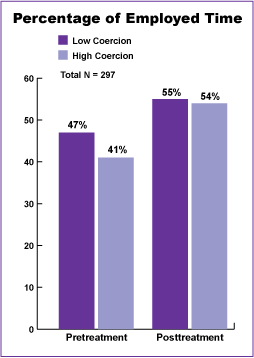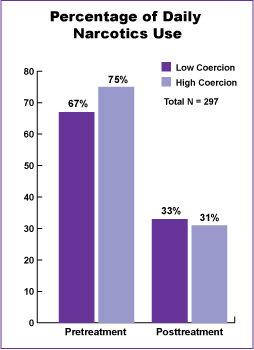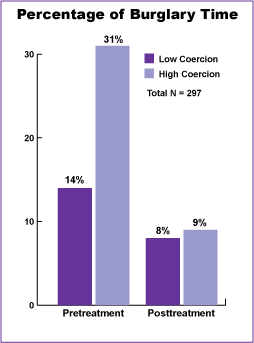Question 17: Is mandated methadone maintenance treatment as effective as voluntary treatment?
Answer: Yes. Mandated methadone maintenance treatment (being forced to attend treatment by the criminal justice system) is as effective as voluntary treatment.
Research Highlights
A study examined the relationship between length of stay in methadone maintenance treatment and referral by legal and nonlegal sources of 2,200 patients. It was determined that patients who are legally referred to methadone maintenance treatment stay in treatment longer than, and do at least as well as, those who seek treatment voluntarily (Collins and Allison, 1983).
A study of 121 male veterans in a 90-day Veterans Administration drug rehabilitation program compared court-referred and voluntary patients. Objective and subjective measures both indicate that the court-referred patient is potentially as responsive to methadone maintenance treatment as the voluntary patient. Sixty-two percent of the court-referred patients were judged to have a good prognosis compared with 58 percent of the voluntary patients (McLellan and Druley, 1977).
Three samples of methadone maintenance treatment admissions, who were treated during the years of 1971 to 1973, participated in a followup study 7 years later. These groups included (1) a random sample of 100 patients, (2) a sample of 136 patients who had a minimum of 30 months remaining on civil addict parole status at the time of admission, and (3) a matched sample of 136 patients not on parole. The addition of parole supervision with urine testing resulted in only marginal improvements in behavior over that attributable to methadone maintenance treatment alone; however, parole status did significantly reduce the length of intervals of daily heroin use both before and after admission (Anglin, McGlothlin, and Speckart, 1981).
Mandated Methadone Maintenance Treatment and Three Treatment Outcomes–Patients who are legally coerced into methadone maintenance treatment experience treatment success at about the same rate as patients who participate voluntarily in treatment.
A study by 36) had moderate legal pressure to participate in methadone maintenance treatment (medium coercion). A third group had mild legal pressure to participate in methadone maintenance treatment (low coercion).

Figure 34 compares the behaviors of individuals in the high-coercion group with those of individuals in the low-coercion group for the treatment outcome of time employed. As the figure illustrates, patients who are coerced in treatment achieve this treatment outcome at about the same rate as patients who voluntarily participate in methadone maintenance treatment (Anglin et al., 1990).

Figure 35 compares the behaviors of individuals in the high-coercion group with those of individuals in the low-coercion group for the treatment outcome of daily narcotics use. As the figure illustrates, patients who are coerced in treatment achieve this treatment outcome at about the same rate as patients who voluntarily participate in methadone maintenance treatment (Anglin et al., 1990).

Figure 36 compares the behaviors of individuals in the high-coercion group with those of individuals in the low-coercion group for the treatment outcome of criminal involvement. As the figure illustrates, patients who are coerced in treatment achieve this treatment outcome at about the same rate as patients who voluntarily participate in methadone maintenance treatment (Anglin et al., 1990).
References
Anglin MD, Brecht ML, Maddahian E. Pre-treatment characteristics and treatment performance of legally coerced versus voluntary methadone maintenance admissions. Criminology 1990;27:537-57.
Anglin MD, McGlothlin WH, Speckart GR. The effect of parole on methadone patient behavior. American Journal of Drug and Alcohol Abuse 1981;8:153-70.
Collins JJ, Allison M. Legal coercion and retention in drug abuse treatment. Hospital and Community Psychiatry1983;34(12):1145-49.
McLellan AT, Druley KA. A comparative study of response to treatment in court-referred and voluntary drug patients.Hospital and Community Psychiatry 1977;28:241-45
In This Section
- Certificate Programs
- Methadone Research Web Guide
- Acknowledgments
- Introduction
- Part A
- Part B
- Question 1: Is methadone maintenance treatment effective for opioid addiction?
- Question 2: Does methadone maintenance treatment reduce illicit opioid use?
- Question 3: Does methadone maintenance treatment reduce HIV risk behaviors and the incidence of HIV infection among opioid-depen
- Question 4: Does methadone maintenance treatment reduce criminal activity?
- Question 5: Does methadone maintenance treatment improve the likelihood of obtaining and retaining employment?
- Question 6: What effect can methadone maintenance treatment have on the use of alcohol and other drugs?
- Question 7: What components of methadone maintenance treatment account for reductions in AIDS risk behaviors?
- Question 8: Do risk factors for HIV infection acquisition and transmission differ for women compared with men in methadone maint
- Question 9: Is methadone maintenance treatment effective for women?
- Question 10: Is methadone safe for pregnant women and their infants?
- Question 11: Is it necessary to reduce methadone dose or detoxify women from methadone during pregnancy to protect the f
- Question 12: Is the long-term use of methadone medically safe, and is it well tolerated by patients?
- Question 13: Are there program characteristics associated with the success of methadone maintenance treatment?
- Question 14: Are there patient characteristics associated with the success of methadone maintenance treatment?
- Question 15: Are there cost benefits to methadone maintenance treatment?
- Question 16: What are the retention rates for methadone maintenance treatment?
- Question 17: Is mandated methadone maintenance treatment as effective as voluntary treatment?
- Question 18: What is the role of L-alpha-acetyl-methadol (LAAM)?
- Question 19: How do buprenorphine and methadone compare?
- Question 20: Can methadone and buprenorphine be abused?
- Part C
- Part D
- Methadone Research Web Guide Tutorial
- Questions: Methadone Research Web Guide
- Answers: Methadone Research Web Guide
- Methadone Research Web Guide
- Degree Programs
- Virtual Lectures
- Research Publications
Important Dates
NIDA International Forum
June 14–17, 2013
Online Registration Deadline:
May 6, 2013
FELLOWSHIPS
IAS/NIDA Fellowships
Application Deadline:
February 10, 2013
NIDA International Program Fellowships
Application Deadline:
April 1, 2013
Global Health Program for Fellows and Scholars
Application Deadlines: Vary
GRANTS
Brain Disorders in the Developing World: Research Across the Lifespan
(Non-AIDS)
R01 PAR-11-030and R21 PAR-11-031
Application deadline:
February 14, 2013
MEETINGS
American Association for the Advancement of Science
February 14–18, 2013
Boston, Massachusetts, USA
International Drug Abuse Research Society (IDARS)
April 15–19, 2013
Mexico City, Mexico
2013 International Conference on Global Health: Prevention and Treatment of Substance Abuse and HIV
April 17–19, 2013
Taipei, Taiwan
Yih-Ing Hser, Ph.D.

.png)


